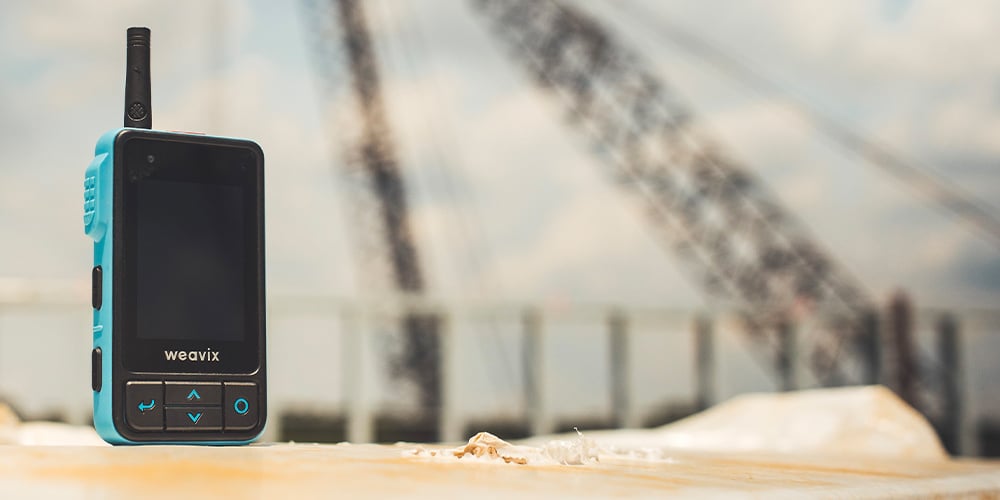Two-way radio systems are powerful tools that let users communicate by converting audio to radio waves transmitted through the air, which are then converted back to audio by the receiving radio. Unlike traditional radios that only transmit information in one direction, two-way radios enable real-time conversation — this is essential for businesses where quick, reliable communication is key.
Two-way radio communication is widely used across construction, food and beverage, and manufacturing industries. They use these devices because they provide a hands-free communication system that keeps their workforce connected and productive, especially in rugged, loud, often challenging environments.
What Is a Two-Way Radio System?
A two-way radio system is a versatile tool that lets users both transmit and receive radio signals, enabling real-time voice communication between individuals or groups. As a result, they make interactive conversations possible.
These systems send and receive information through radio waves. This conversion to radio waves can be sent as either an analog or digital signal, with the digital being the more modern technology. For example, digital makes it possible to send other types of data over the radio waves like text messages. It is also possible to encrypt data to stop others from using your network without your permission.
Whether coordinating a construction project, managing emergency response teams, or ensuring smooth transportation logistics, these devices provide an indispensable solution for maintaining connectivity and enhancing operational efficiency.
Keep reading: Why phones don't work for the frontline

Types of Business Two-Way Radios
Business two-way radio systems come in a few different types, each meant for specific operational needs. Here’s a quick overview:
Analog Two-Way Radios
Analog two-way radios are the trusty old go-to. They’ve been a staple in business communication for decades because they’re simple and cost-effective, giving users clear audio for short-range communication. But analog systems lack all the advanced features like encryption or interference rejection.
Digital Two-Way Radios
Digital radio systems have largely replaced analog due to their enhanced capabilities, such as clearer audio quality, extended range, and greater privacy. They transmit not only audio but also additional data like text messages and encrypted information, which improve workforce management. Capabilities include:
- Enhanced Audio Quality: Noise-canceling technology filters background noise
- Increased Battery Life: Digital radios are much more energy-efficient
- Encrypted Communication: Ensures secure transmission
Analog vs. Digital Two-Way Radio Systems
|
Feature |
Analog Radios |
Digital Radios |
|
Audio Quality |
Moderate |
Clear |
|
Communication Range |
Limited |
Extended |
|
Battery Life |
Standard |
Longer |
|
Security |
Limited |
Encrypted |
Push-to-Talk Radios
Push-to-talk (PTT) radios take communication to another level, boosting range exponentially by bringing cellular LTE networks into the mix. They allow users to press a button to communicate instantly, emphasizing their portability and versatility for communication on the job. But the real benefit is usability anywhere Wi-Fi or LTE signal is available.
This setup is ideal for quick, hands-free communication for teams that require greater range, like connecting workers across multiple construction sites or linking an entire frontline workforce at different manufacturing facilities across the country.
Smart Radios
Here’s where things really start to get interesting. Smart radios, like those offered by weavix, combine the traditional functionality of two-way and push-to-talk radios but they add advanced, AI-powered features. The weavix platform and walt Smart Radios surpass all others to enhance communication beyond simple voice messaging. How? By incorporating tools like:
- AI language translation
- Multimedia messaging
- Safety alerts
How Do Smart Two-Way Radios Work?
Smart two-way radios operate by connecting to both public and private LTE cellular networks and Wi-Fi, giving users a hybrid communication experience that adapts to different environments and locations. Combining modern hardware with advanced data capabilities lets smart radios facilitate communication across language barriers and allows users to share images, videos, and documents instantly.
Licensing and Regulations
In the United States, the Federal Communications Commission (FCC) regulates the use of two-way radios and requires users to obtain a license to operate on certain frequencies. The type of license depends on the application and the radio’s power level. Users must also comply with FCC regulations regarding radio frequencies, power levels, and antenna heights.
The beauty of using a communication system like the weavix platform and walt Smart Radio is that you don’t need to worry about rules and regulations when it comes to communication because our systems use Wi-Fi and LTE connectivity to connect workers wherever they are.
Why Choose a Smart Two-Way Radio Communication System
A smart two-way radio system is an investment in seamless communication and enhanced productivity. Their extreme mobility and advanced capabilities make them an ideal long-range communication and connection tool.
Here are six key reasons to choose them:
1. Extend Your Communication Range
Smart radios give workers and businesses global connectivity through LTE and Wi-Fi networks, enabling teams to stay connected across long distances, including remote or expansive job sites.
Keep reading: How to choose the ideal network type
2. Provide AI-Powered Language Translation
For businesses with multilingual teams, AI-powered translation gives real-time interpretation, bridging language gaps on the frontline. That means employees who once were on their own are now a fully integrated part of the team.
3. Enable Multimedia Messaging
Smart radios give teams multimedia messaging, meaning users can send images, audio, and even videos. This feature is invaluable in situations where visuals are the best tool to convey information quickly.
4. Go Beyond Push-To-Talk Capabilities
With traditional PTT radios, communication is limited to voice. Smart radios combine voice, picture, and video messaging, enabling additional features like message playback. These push-to-three (PT3) capabilities allow for more versatile interaction on the go.
Keep reading: What Is PT3?
5. Offer Unlimited Channels
Unlike traditional two-way radios, which have limited channels, smart radios provide unlimited channels for teams to set up specific groups for departments, projects, or locations.
6. Enhance Worker Safety
Smart two-way radios make workers safer with features like GPS tracking and emergency alerts and a man-down button. With safety solutions, if there is an incident, supervisors can monitor locations and respond immediately.
Traditional vs. Smart Two-Way Radio Capabilities
|
Feature |
Traditional Radios |
Smart Radios (weavix) |
|
Communication Range |
Limited |
Global |
|
Language Translation |
No |
AI-Powered Translation |
|
Multimedia Messaging |
No |
Yes |
|
GPS Tracking |
Limited |
Advanced GPS Capabilities |
|
Safety Alerts |
Basic |
Comprehensive Safety Suite |
Keep reading: Understand the Differences between Legacy and Smart Radios
Industries That Use Two-Way Radios
Two-way radios are essential tools in so many different industries, each benefiting from the unique advantages these systems offer:
- Construction: These devices are crucial for coordinating teams, managing projects, and ensuring worker safety. The instant communication they provide is vital for addressing issues and maintaining productivity.
- Hospitality: Hotels, restaurants, and other hospitality providers use two-way radios to communicate with staff to manage operations and keep guests and staff safer, ensuring a seamless experience.
- Manufacturing: This industry uses two-way radios to communicate with workers on the production floor to manage inventory and coordinate logistics. This enhances operational efficiency, reduces downtime, and boosts safety.
Empower Communication with the Right Commercial Two-Way Radio System
Choosing the right two-way radio can make a significant difference in communication efficiency and safety. Commercial systems with smart capabilities not only offer mobile two-way radio connectivity but also enable seamless communication that extends far beyond voice.
For manufacturing, construction, and hospitality businesses aiming to enhance productivity and team coordination, weavix's communication solutions provide a modern approach to frontline communication, tailored to meet the complicated demands of today’s industries.
By using a digital two-way radio system that integrates smart, AI-powered features, businesses can create a connected, agile workforce prepared for real-time collaboration. If you’re looking to change the way you communicate and operate to improve every aspect of your business, it’s time to consider weavix as your partner in transforming the way your team communicates. Request a demo now.
Subscribe
Don’t miss out on industry news and information. Subscribe to interweave, the official weavix™ blog today.


